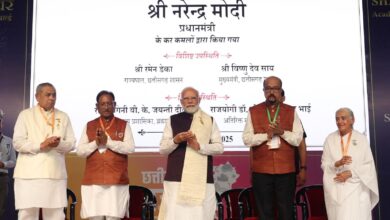100,000 warehouses identified for bringing under the fold of the WDRA: Anita Praveen, Chairperson, WDRA

Rural consumption shifts significantly, with beverages and processed foods surpassing cereals in expenditure for the first time: FICCI-Deloitte White Paper.
NEW DELHI, 21 May 2025: India has identified more than 100,000 warehouses as part of a push to reduce post-harvest losses, noted WDRA Chairperson Anita Praveen at the 16th FICCI Foodworld India 2025 conference..
“Today, we have over 100,000 identified warehouses, and we are trying to bring in as many as possible into the fold of the WDRA,” said Anita Praveen.
The integration of warehousing and food processing is considered crucial for handling India’s growing agricultural production, which continues to increase year after year. “The food processing sector and warehousing are two very crucial players as far as the surplus food is concerned. Otherwise, we end up with lots of losses of food,” Praveen said.
Speaking on 20th May on the occasion, G. Kamala Vardhana Rao, Chief Executive Officer of FSSAI, highlighted the changing consumer landscape, noting that “most people no longer go to supermarkets to pick up products. Now everything is coming home—supermarkets are coming home.” Rao also addressed the shifting consumption patterns towards packaged and processed foods, urging the industry to consider its “great social responsibility” to ensure proper nutrition content in products as consumers increasingly rely less on home-cooked meals.
The Ministry of Food Processing Industries has made remarkable strides in developing the sector’s infrastructure. Ranjit Singh, Joint Secretary, noted that the government has funded nearly 1,600 projects, creating a food processing capacity of 4.1 million tonnes and benefiting approximately 900,000 farmers. The Production Linked Incentive scheme has catalysed investments worth ₹7,000 crores and generated over 250,000 employment opportunities across the country.
Hemant Malik, Chair of the FICCI Food Processing Committee and Executive Director, ITC Ltd & Div CEO ITC Foods, expressed industry concerns about the labelling debate, advocating for serving-size-based front-of-pack nutrition information rather than per-100g measurements, since “most consumption of packaged food is in small sizes,” and cautioned against broadly categorising packaged foods as “ultra-processed,” citing examples such as soy nuggets, which provide affordable protein despite being processed products.
Jyoti Vij, Director General of FICCI, highlighted rural prosperity as a priority for FICCI, emphasising that the food processing sector holds immense transformative potential in realising this vision. She noted that the sector enables value addition at the farm gate, fosters entrepreneurship in tier-2 and tier-3 cities, and reduces post-harvest losses—ensuring economic growth reaches the grassroots.
On occasion, the FICCI-Deloitte White Paper, “Spurring Growth: Driving Innovation and Unlocking Opportunities in the Indian Food Processing Sector,” was released. The paper highlighted that India’s food processing sector is undergoing transformative growth driven by rising disposable incomes and evolving consumer preferences.
Key Findings:
· India’s food processing sector contributes ~7.7% to total manufacturing GVA and generates ~7 million jobs.
· Rural consumption is shifting significantly, with beverages and processed foods surpassing cereals in expenditure for the first time
· 77% of consumers prioritise high-protein foods, while 71% prefer low/no-sugar options, indicating strong health-consciousness
· Premium products constitute 27% of the overall FMCG market but contribute 42% to total growth
· Indian processed food exports valued at ~US$48 billion (16% of agriculture exports), far below the potential compared to peers like Thailand (56%)
· Key growth opportunities include millets, makhana, and other native superfoods reformulated for global wellness trends
· Six strategic imperatives identified: innovation, rural market expansion, health-focused products, public-private collaboration, export promotion, and technology integration
· Quick commerce is emerging as a significant channel, reshaping convenience and impulse consumption patterns· India processes less than 10% of its agricultural output (4.5% for fruits, 2.7% for vegetables, 21.1% for milk), indicating significant growth potential







